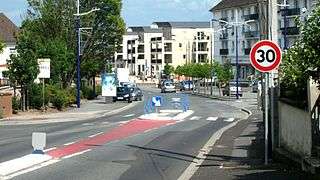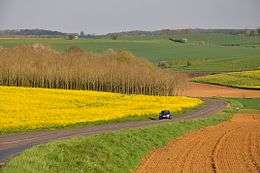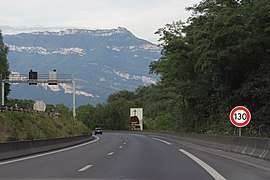Speed limits in France
French roads have a variable speed limit that depends on weather conditions. In dry weather rural 2- or 3-lane roads are limited from July 2018 to 80 from 90 km/h, 4-lane expressways (in rural areas) 110 km/h, and highways (in rural areas, when classified as motorway) 130 km/h. When raining, the limits are respectively lowered to 80[1], 100, and 110 km/h. Urban speed limit of 50 km/h is unaffected by weather. The general speed limit is lowered to 50 km/h on all roads in the fog or other low-visibility conditions if visibility is under 50 metres.
Those limits are not systematically signaled as they are the default limit. For instance the name of a city at its entry is an implicit limitation to 50 km/h; the crossed name at the output is the corresponding end of limit. However, additional 50 km/h speed limit signs might be added to make it more explicit.
Vehicles over 3.5 metric tons of maximum total weight have lower speed limits. Lorries of more than 12 metric tons (except dangerous goods and trailers that may have lower limits) may not exceed 50 km/h in urban areas (even if the speed limit was raised to 70 km/h), 90 km/h on highways, and 80 km/h elsewhere. Lorries under 12 metric tons but over 3.5 have the same limits except 90 km/h on 4-lane expressways. Buses may not exceed 100 km/h on highways and 4-lane expressways.
Minimum or recommended speeds are very rarely marked in France, though vehicles incapable of sustaining 60 km/h are not allowed on highways/motorways and you must be driving at 80 km/h or higher to use the left-most lane of a highway/motorway. Posted speed limits, to conform to the French Highway Code, must be in odd multiples of ten (e.g., 10, 30, 50, etc.), though you can still see 40, 60 and 80 sometimes.
However the 80 km/h has become the default speed limit on a network of around 400 000 kilometers of road. Protests against the lowering of the speed limit on rural roads to 80 km/h are still ongoing due to the unpopularity of the decision, on the basis that this is unrealistically slow and that there has been insufficient assessment done to deal with issues of road design and signage at potentially more dangerous locations.
Additional limits to the speed limits
Article R413-17 of the Code de la route provide some clarifications regarding the speed limits.
- It clarifies that those speed limit are designed for conditions where traffic is optimal, weather is clear, and the vehicle in a good condition.
- It clarifies that to fix its speed the driver should take into account carriage, traffic and obstacles.
- It clarify the need to reduce the speed, when there are pedestrians, cyclists, convoy, transport vehicle and travelers, few visibility or sliding road, rain or fog, curve, downing sloping road, small streets or roads with residential buildings, in the high points and intersections when there are few or no visibility, usage of the low beam (for instance at night or in a tunnel), or animals[2].
History and trends
In some cities, 30 km/h is being developed as a common speed limit in zone 30 to provide greater security with pedestrian and cyclists.
 A street with a 30 km/h speed limit in Bellerive-sur-Allier.
A street with a 30 km/h speed limit in Bellerive-sur-Allier.- A "Zone 30" zone near of gare de Moulins-sur-Allier.
In 2005, a governmental report advised lowering the higher highway speed to 115 km/h in order to save fuel and reduce accident risks, but this proposal was badly received. Since 2002, the French government has installed a number of automatic radar guns on autoroutes, routes nationales, and other major thoroughfares. These are in addition to radar manned by the French National Police and the Gendarmerie. The French authorities have credited this increase in traffic enforcement with a 50% drop in road fatalities from 2002 to 2006 (except on Motorways, where the fatalities rose by 15% between 2002 and 2006).
It is expected that the French government gives on 9 January 2018 a statement to define 80 km/h (instead of 90) as a standard speed limit on secondary network, due to the many fatalities existing on this network. This occurs after an experimentation which included a speed limit change from 90 to 80 between 2010-2015 and 2015-2017 seemed to show it is possible to reduce fatalities.
The 80 km/h national limit enter into force on first july, this same year.
Preliminary ONISR results of July 2018 make possible a decrease of fatalities between month of july 2017 and july 2018: [3]
- fatality decrease of 5,5% in France and 6% in mainland[3].
- injured decrease of 2,1%[3].
- 24 hours hospitalization decrease of 10,5%[3].
- increase of 0.9% of accidents with injuries [3].
The link between those preliminary results and the change of speed limit is not yet established, in august 2018. Protests against the 80 km/hr limit on rural roads are on-going on the basis that they are unrealistically slow and there has been insufficient assessment of other factors of road and signage design.
Preliminary ONISR results of August 2018 make possible a decrease of fatalities between month of August 2017 and August 2018: [4]
- fatality decrease of 15.5% in mainland France (46 saved lives)[4]; fatality decrease of 30.4% in oversea France (7 saved lives)
- injured decrease of 2.1% in mainland France[4].
- 24 hours hospitalization decrease of 13,3% in mainland France[4]; 24 hours hospitalization decrease of 9.0% in oversea France
- decrease of 3.2% of accidents with injuries in mainland France[4].
In august, some vandal painted speed camera to protest against 80 km/h speed limit as they are angry[5].
According to a RAC representative
While the decision will not be popular with French motorists, we know from experience in the UK that those roads are responsible for far more deaths than motorways and dual carriageways. We also know that speed is one of the biggest contributory factors in injury accidents[6].
Stone Chasseray, General delegate of the association “40 million motorists”, critics the measure as undemocratic and for the lack of transparency on road fatalities[7]
On the other hand, Chantal Perrichon, President of the League against road violence, support the governmental initiative as a measure required to save lives, but she is also critic of the lack of transparency as the government did not publish data related to fatalities[8].
 Urban motorways might have a specific speed limit. Here a 70 km/h speed limit in the bridge pont d'Aquitaine near Bordeaux
Urban motorways might have a specific speed limit. Here a 70 km/h speed limit in the bridge pont d'Aquitaine near Bordeaux Simple roads (with only two lanes) like the D978 near of Logny-Bogny, Ardennes are nowadays usually limited to 80 km/h, in their interurban parts
Simple roads (with only two lanes) like the D978 near of Logny-Bogny, Ardennes are nowadays usually limited to 80 km/h, in their interurban parts Ring (Urban expressway) Exit 12, with it 90 kmh speed limit. Since july 2018 the 90 km/h should only exist when there is a median separation.
Ring (Urban expressway) Exit 12, with it 90 kmh speed limit. Since july 2018 the 90 km/h should only exist when there is a median separation. A 110 km/h speed limit (recall) on motorway A43 autoroute through the French Alps
A 110 km/h speed limit (recall) on motorway A43 autoroute through the French Alps Regular 130 km/h speed limit on regular interurban motorway (A41 autoroute) between Grenoble and Geneva.
Regular 130 km/h speed limit on regular interurban motorway (A41 autoroute) between Grenoble and Geneva.
References and Sources
- ↑ Article R413-2 of the Code de la Route, applicable on September the first 2018, as available by legifrance
- ↑ Article R413-17 of the Code de la route
- 1 2 3 4 5 http://www.securite-routiere.gouv.fr/medias/espace-presse/publications-presse/baisse-de-la-mortalite-sur-les-routes-de-france-en-juillet-2018
- 1 2 3 4 5 http://www.securite-routiere.gouv.fr/medias/espace-presse/publications-presse/baisse-de-la-mortalite-sur-les-routes-de-france-en-aout-2018
- ↑ https://www.thetimes.co.uk/article/speed-cameras-vandalised-in-protest-against-lower-limits-8kslh8d37
- ↑ https://www.rac.co.uk/drive/travel/driving-abroad/speed-limits-in-france/
- ↑ https://koztimes.com/a-80-km-h-at-full-speed/1270/
- ↑ https://koztimes.com/limit-the-speed-to-80-km-h-was-required-simply-to-save-lives/1273/
- Sécurité Routière, Ministère de l'Écologie, de l'Énergie, du Développement durable et de la Mer, Délégation à la sécurité et à la circulation routières, RCS paris b 562 111 732, July 2009.
- Decree n°73-1073 or the "Code de la route", 3 December 1973, Journal Officiel, page 12844.
- Code de la route (available at http://www.legifrance.gouv.fr/):
- Article R413-2
- Article R413-4
- Article R413-3